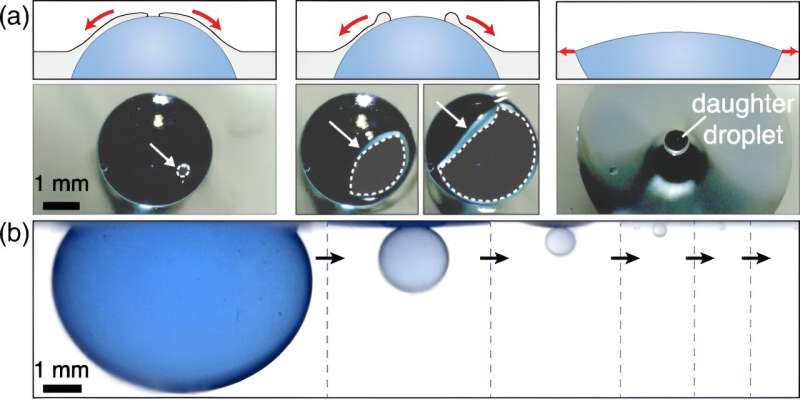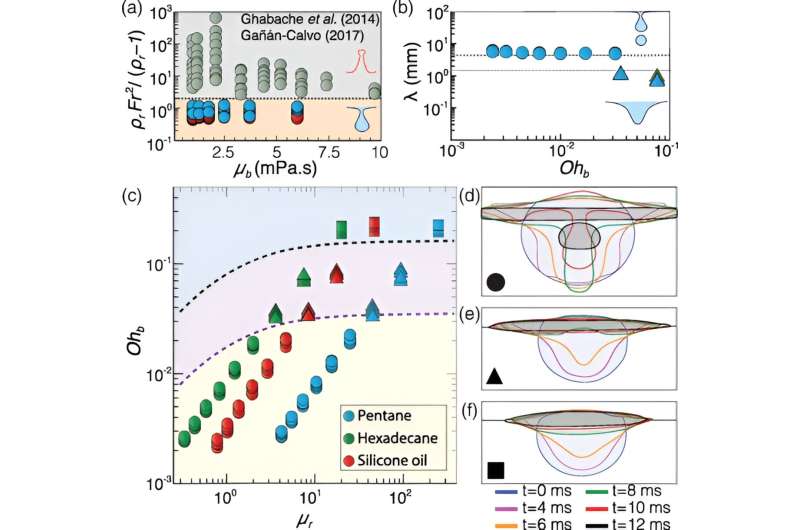This article has been reviewed according to Science X's editorial process and policies. Editors have highlighted the following attributes while ensuring the content's credibility:
fact-checked
peer-reviewed publication
trusted source
proofread
Bursting of underwater oil drops: How pollution may remain in water after oil spill cleanups

Oil drops from underwater oil spills can break into tinier droplets at the surface that remain suspended in the water, according to research from the University of Illinois Chicago. That means cleanups after disasters like the Deepwater Horizon spill may be removing less oil from the environment than was thought.
Because oil is lighter than water, it rises through the ocean after spills, which are usually caused by leaking underwater pipelines or sometimes by natural processes. It was believed that when these oil drops reached the water's surface, they simply turned into a flat film, forming an oil slick.
A UIC team led by Sushant Anand was the first to look more deeply into the mechanics of how oil goes from being a drop to a slick, and they discovered a different pattern. They found that when oil drops reach the water's surface, they remain partially submerged for awhile.
When the thin film of water that covers the exposed part of the drop breaks, that part of the drop spreads across the water surface into a film. But the part of the drop that was below the surface deforms, breaking off into a smaller "daughter" drop. The process repeats with that smaller droplet, over and over. The research is published in the journal Physical Review Letters.
That means some oil from spills remains permanently underwater. This is a problem from an environmental standpoint because oil spill cleanups have focused on the slick that forms above the surface, said Anand, an associate professor in UIC's College of Engineering and senior author on the paper.

"Unfortunately, underwater oil spills do routinely happen, so understanding the mechanics of oil dispersion is crucial for developing effective cleanup strategies," Anand said. "Our discovery sheds light on a previously unknown pathway by which oil can spread pollution inside the ocean." And the smaller an oil droplet is, the harder it is to clean up, he added.
The researchers found that increasing the viscosity of the water can help keep the oil drops intact so the entire drop goes into the oil slick above the surface, making cleanup easier. Perhaps a biodegradable, water-soluble compound could be added at the location of a spill to increase water viscosity and prevent the formation of daughter drops, Anand said.
This process of drops breaking apart isn't limited to underwater spills in the ocean, he said. Pipelines run under lakes and rivers, too. And an oil spill from a ship has enough force to send the oil underwater before it rises to the surface and breaks up using the same mechanism as oil spills that originate underwater.
Anand said he hopes further research investigates how these tiny droplets impact underwater species. Oil companies, which use models to predict the size and spread of spills, should consider incorporating this information into their calculations, he added.
The other authors of the study, all in the UIC Department of Mechanical and Industrial Engineering and part of the Anand Research Group, are Varun Kulkarni, Venkata Yashasvi Lolla and Suhas Tamvada.
More information: Varun Kulkarni et al, Bursting of Underwater Oil Drops, Physical Review Letters (2024). DOI: 10.1103/PhysRevLett.133.034004. On arXiv: DOI: 10.48550/arxiv.2204.04804
Journal information: Physical Review Letters , arXiv
Provided by University of Illinois at Chicago





















